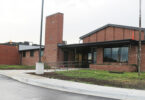How do we get faith-filled Catholic school students? By starting with a faith-filled faculty
by Joe Bollig
joe.bollig@theleaven.org
KANSAS CITY, Kan. — It’s probably the biggest question we can ask ourselves about Catholic education: How do we measure the success of our Catholic schools?
Is it top-notch academics? Successful sports teams? A high graduation rate? The number and amount of scholarships won by graduates?
All those things are important and good, said Archbishop Joseph F. Naumann. We ought to have them — and frequently do.
But they’re not the bottom line.
The ultimate purpose lies elsewhere, said the archbishop.
“To me, those aren’t the measures of success for Catholic schools,” he said. “To me, the key thing is that every student — when they complete their Catholic school education — that they have a relationship with Jesus Christ.”
“[They must have] a friendship with Jesus Christ,” he continued, “that will sustain them for a lifetime — a love for the church and an understanding of all that’s offered to them in the sacramental life of the church to nurture that friendship.”
The opposite is the definition of failure, he said, no matter how high the grades are or how many games are won.
So this is the million-dollar question: How do we form Catholic school students to become great disciples of Christ?
The answer? Help their teachers to become great disciples of Christ.
Success and identity
The mission and identity of Catholic schools have long been a concern of Kathy O’Hara, archdiocesan superintendent.
“Since I’ve been at the chancery, the archdiocesan school office has been involved in trying to enhance the Catholic identity and culture of our schools,” said O’Hara.
More than five years ago, the archdiocesan school office began to study what it meant to be a successful Catholic school in the three areas of curriculum, environment and personnel.
The first two were easy. But the third wasn’t. A new approach was needed.
“We created a mission team to look at what it means to be a Catholic school,” said O’Hara. “At the same time, we determined we needed to do a better job with the theological formation of our teachers. St. James Academy in Lenexa [opened] and they asked if they could take a different approach to faculty faith development.”
All the while this was happening, other ideas and influences were coming from the archdiocesan school office, the St. Lawrence Center, the Holy Family School of Faith, the Benedictine Institute for Religious Studies, and various principals.
Mike Scherschligt, executive director of the School of Faith, offered to help Archbishop Naumann in his vision of making better disciples.
Scherschligt helped St. James build a program for faculty that included not only academic formation, but also prayer and community formation. After refining the program through trial and error, he offered it to a couple of pilot schools three years ago. By fall 2009, there were 18 archdiocesan schools in the Holy Family School of Faith faculty formation program.
A paradigm shift
The new faculty formation program is a radical departure from what went before.
“What we used to do prior to the School of Faith was to hold certain classes regarding the faith at various locations, and the teachers would sign up for the classes,” said O’Hara.
“Sometimes a principal would arrange to have a class offered so all the teachers could take it,” she continued, “but the emphasis was on individual learning, not trying to develop the faculty as a community of faith.”
Also, the emphasis of these classes was on the teachers learning things for direct, practical application in the classroom.
Certainly there was learning, and teachers did benefit, but the old paradigm did not offer ongoing formation or community.
“That continued conversion process that needs to occur in each person just doesn’t happen,” said Scher- schligt. “We just don’t work on that once a semester or once a year. It has to be an ongoing process for everybody. So, the first step was to move this formation from infrequent to regular, consistent, ongoing formation.”
The old approach primarily offered classes, but the new approach offers this and more.
“These are much more than classes,” said Scherschligt. “There is an intellectual and catechetical piece, but [it offers] a deeper training in prayer and the interior life.”
The teachers used to take classes as individuals; now, they undergo training together with the faculty formation program.
“Each faculty is taken as a group,” said Scherschlight, “and one of the goals is to help them to grow in a greater friendship and as a community, because their unity with each other will enable them to be more successful in their mission.”
How it works
The School of Faith sends instructors to each participating school to help the principal, staff and faculty complete 30 hours of formation in an academic year.
During these 30 hours, typically divided into 15 hours per semester, the faculty and staff receive four kinds of religious formation, referred to as “pillars.”
The first pillar is intellectual formation, done by studying the Scriptures, the Catechism of the Catholic Church, the theology of the body, and Catholic moral principles, social doctrine, and virtues.
The second pillar is interior formation, which focuses on developing a deep relationship with Christ through prayer.
The third pillar is community and friendships, which is accomplished by forming closer bonds, or relationships, in the faculty.
The fourth pillar is apostolate, where this faith is witnessed and handed on to the students in every way that faculty and staff encounter the students.
The faculty formation takes place in a retreat setting and often involves the participants having a meal together, small group discussion, and prayer. Some schools have full days; others have half-days and spread the remaining hours out over the semester.
St. Joseph School in Shawnee has participated in the program for two years. This year, school administrators chose to divide its hours into two full days, supplemented by half-days.
“This is deepening our sense of community and helping us to develop a more faith-filled interior life that we can share with our students,” said Sue Carter, principal at St. Joseph.
“I think it has really impacted [faculty],” she continued. “This time in the School of Faith is for us. It’s not about what we can take back to the classroom, although that’s a side ben- efit. It’s about growing and becoming more faithful ourselves, which, in turn, enriches what we do in the classroom.”
Resurrection Catholic School at the Cathedral in Kansas City, Kan., is finishing its third year in the program. The faculty there spend a half-day in formation every month.
“We have a portion of time we spend learning about some aspect of our faith,” said Ann Connor, principal. “It might be on salvation history, the New Testament, or the saints. And then we roll into prayer time, and we learn different types of prayer that we can take into our own personal life.”
Connor has noticed that the formation is having an impact on the way her teachers pray. They used to stick to the rote, traditional prayers. Now, their prayer with God is more conversational.
“They are listening more and being more open to what God is telling them,” said Connor.
Participation is required, but faith formation is something the teachers look forward to. The greatest challenge the school has encountered was figuring out the best time for the formation.
“The initial challenge was time — figuring out what worked out best for our teachers, and when they would be most open and productive to what the program is designed for,” said Connor.
“Once we got that figured out, the next [challenge] was that not everyone is at the same level in their faith life,” she continued. “We make sure everyone is comfortable with the program and able to share in the way they feel the most comfortable.”
From what she has observed, the program is delivering what it promised.
“Our staff has come together as a faith community in the way they deal with students, parents and each other,” said Connor.
Atchison Catholic School is also completing its second year in the program.
“The biggest challenge was getting the teachers to ‘buy into’ the program — understanding why we were doing it and how it was going to help us,” said principal Rick Weber.
But the benefits of the program are readily apparent.
“The biggest benefit I see is that our teachers in the class are asking deeper questions,” he said. “These are questions they may not feel comfortable asking their pastor, but they feel comfortable asking an instructor.”
Looking ahead
Scherschligt and his instructors will continue to fine-tune the program, even as they are making plans to expand.
On April 16, the archdiocesan school office and the School of Faith held a presentation for 32 schools at Savior Pastoral Center in Kansas City, Kan. Scherschligt is hoping the 32 will sign on for the next academic year.
He hopes that within two years, this new model of faculty faith formation will be rolled out in all 44 archdiocesan primary and secondary schools.
“There’s an old saying,” he said. “You can’t pass on what you don’t have.”
Ultimately, the success of the program will not be the number of schools that are participating — although that is important. The bottom line for success is teachers bringing the Catholic faith to their students.
“If there is commitment [by teachers] to take on a way of life as a disciple of Christ,” said Scherschligt, “and if they are committed to ongoing growth in a deeper life in prayer, in virtue, and in relationships with those they work with, then we will have created a culture in our schools where the students can pursue discipleship.”






